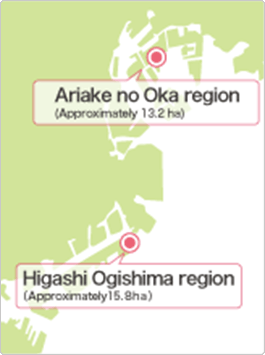筹建经过
 在以东京为中心的首都圈,人口十分密集,职能高度集中,是日本政治、经济的中心。根据阪神淡路大地震的受灾情况可以推测出,这里一旦发生大规模灾害,灾情将扩大到都外的多个县区,带来严重的后果。为了防患于未然,做好应对大规模灾害的准备工作,根据“都市再生项目第一次决定”的内容,特在东京湾临海区域开展了骨干广域防灾基地的筹建工作,并在有明之丘地区和东扇岛地区开展了活动。其目的在于,建立一个与首都圈各地的广域防灾基地相呼应,可开展抗灾救险活动的基地。
在以东京为中心的首都圈,人口十分密集,职能高度集中,是日本政治、经济的中心。根据阪神淡路大地震的受灾情况可以推测出,这里一旦发生大规模灾害,灾情将扩大到都外的多个县区,带来严重的后果。为了防患于未然,做好应对大规模灾害的准备工作,根据“都市再生项目第一次决定”的内容,特在东京湾临海区域开展了骨干广域防灾基地的筹建工作,并在有明之丘地区和东扇岛地区开展了活动。其目的在于,建立一个与首都圈各地的广域防灾基地相呼应,可开展抗灾救险活动的基地。
国营东京临海广域防灾公园的筹建经过
| 2001年6月 | 都市再生本部会议(第2次) 在都市再生项目第一次决定中,被定位为“东京湾临海区域骨干广域防灾基地的建设” |
|---|---|
| 2002年7月 | 召开首都圈广域防灾基地整备协议会(第5次) 决定了具体的建设地点(有明之丘地区、东扇岛地区)及规划建设的方法 |
| 2002年12月 | 作为国营公园开始启动事业 |
| 2003年3月 | 都市公园法施行令进行了部分修改 |
| 2003年11月 | 决定都市计划 |
| 2004年1月 | 首都圈广域防灾基地整备协议会(第7次) 决定东京湾临海部骨干广域防灾基地整备基本计划 |
| 2004年2月 | 都市计划事业得到批准 |
| 从2004年度起 | 防液化工程开始施工 |
| 从2005年度起 | 本部大楼建筑工程开始动工 |
| 2007年度末期 | 本部大楼工程竣工、防液化对策施工结束 2008年6月本部大楼(有明之丘骨干广域防灾基地设施)开始提供使用 |
| 从2008年度起 | 建设园区及体验学习设施 |
| 2011年度 | 2011年度东京临海广域防灾公园全面开园(预定) |
